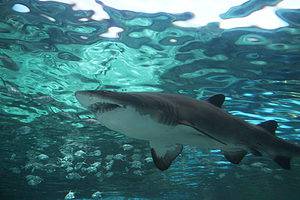Continue reading for our analysis...
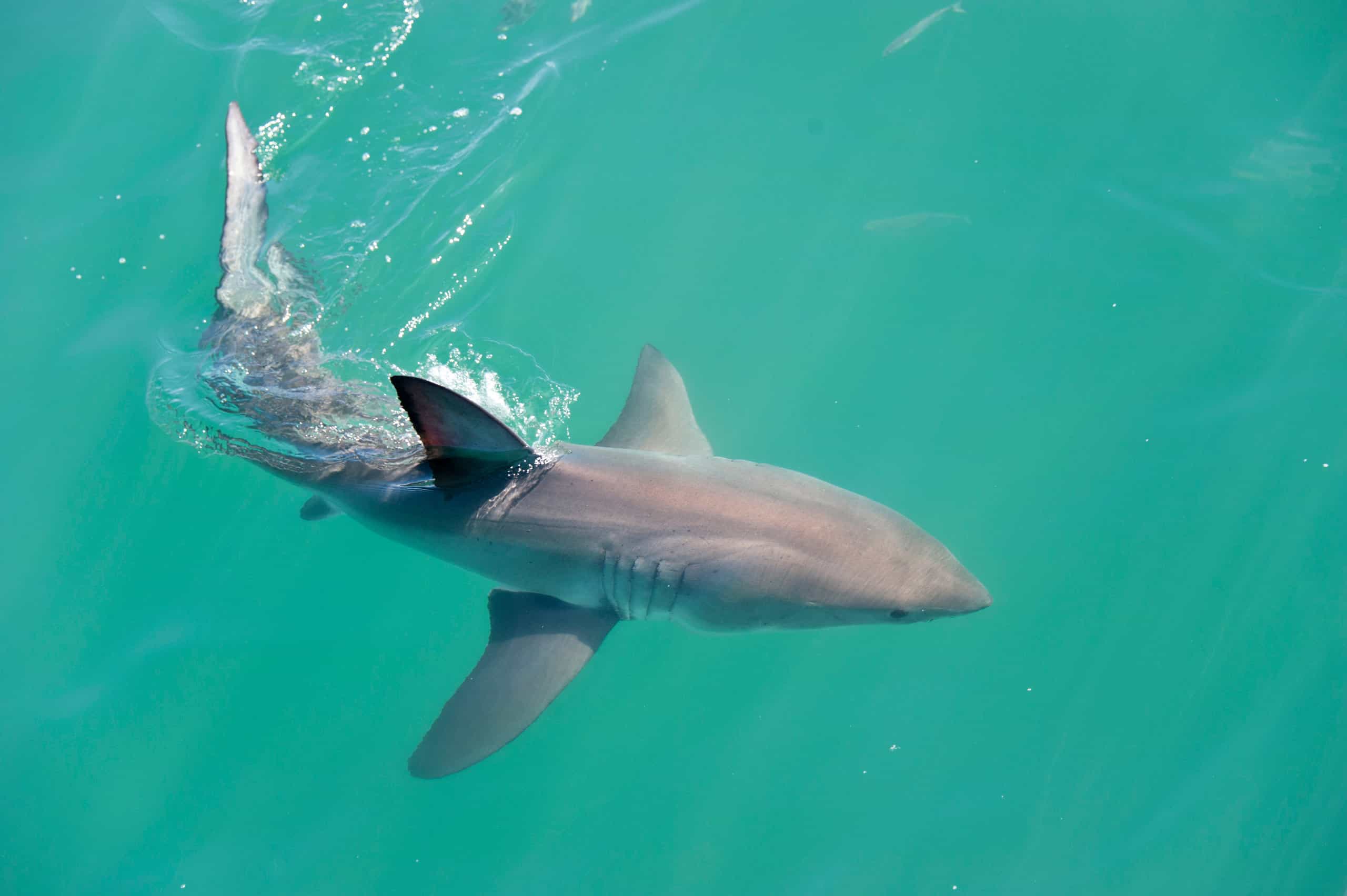
A first glance, this title is quite alarming! After all, who wants to see a child in danger of being injured by a shark? But we’ve done the research for you and sourced the full version of this short clip and the explanation of what was happening which is very reassuring. This incredible scene shows a child on a boogie board being pursued by a juvenile great white shark.
Because of the shark’s immaturity and behavior, we know that the child is not in danger at any time. Sharks have an unfortunate reputation but they are fascinating and curious animals as we see in this clip. In the end, this young shark loses interest in the human and swims away.
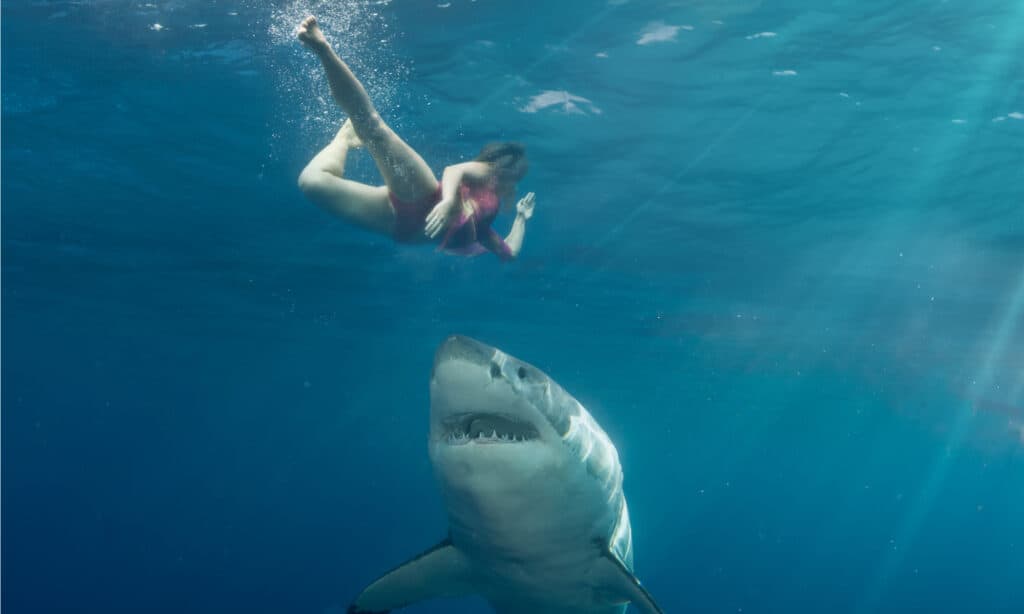
Great white sharks are the largest predatory fish in the world, with some individuals growing up to 20 feet in length and weighing over 5,000 pounds.
©Willyam Bradberry/Shutterstock.com
The Great White Shark
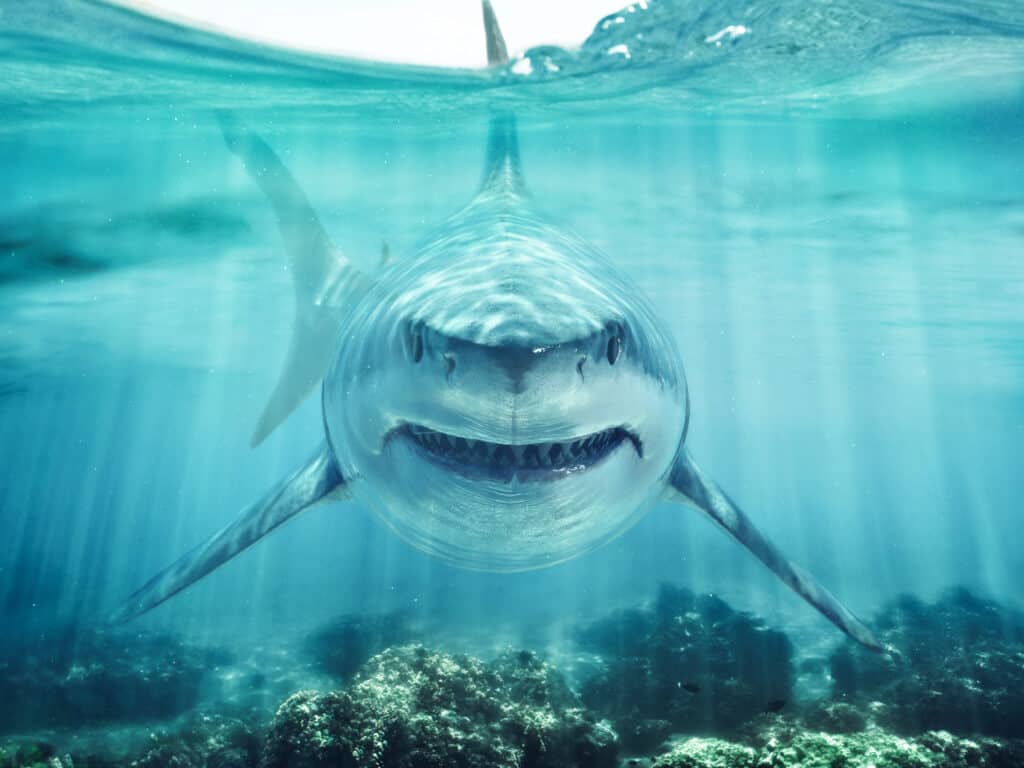
Great white sharks are apex predators, meaning they are at the top of the food chain and have no natural predators
©Digital Storm/Shutterstock.com
This awesome animal is found in oceans all over the world mainly in temperate and tropical coastal waters. They can grow to 16 feet in length and weigh up to nearly 5,000 pounds making them the largest predatory fish species in the world. The shark in this video is young and therefore less dangerous. Great Whites reach sexual maturity at around 17 years old and can live for at least four decades.
The boogie border in this video may not be able to see the shark at all even though we can clearly see it from above. If he is aware, he is playing it exceptionally cool! Sharks are actually very well hidden when they hunt by stealth at the surface.
Their skin, made up of tiny tooth-like structures called denticles, is a slate-grey color and hides them when they are on the rocky shores at the coast. Their bellies are bright white – hence their name.
The light color blends in with sunlight glinting on the surface of the water and makes it even harder to see. Prey such as sea lions and seals can’t spot them very easily either!
Spotting The Great White
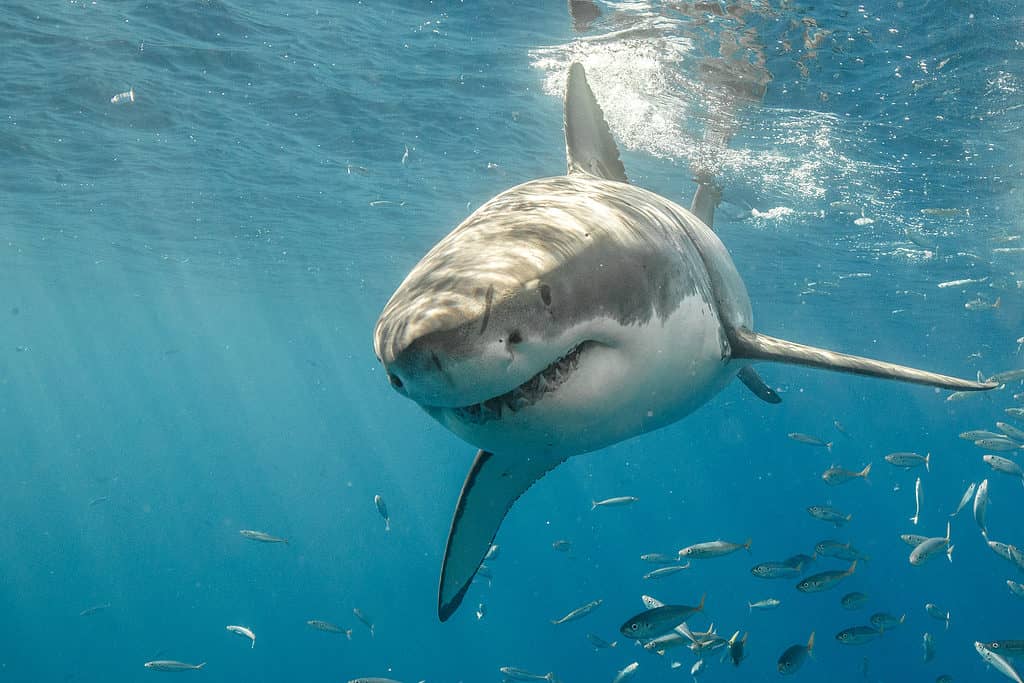
Great white sharks account for 50% of all shark attacks
©iStock.com/ShaneMyersPhoto
Half of all shark attacks are down to the great white so it is helpful to be able to spot one!
They have a distinctive appearance. You should be able to recognize the torpedo-shaped body with a pointed nose. The powerful and crescent-shaped tail fin is used to propel them through the water at some speed. These sharks can reach a top speed of 25 miles an hour making them the fastest swimmers in the sea.
A pair of large pectoral (side) fins stops them from sinking and their infamous dorsal (back) fin helps them to balance and change direction. The jaw is also very characteristic. It has around 300 serrated, triangular teeth which are arranged in several rows.
The myth that sharks have poor eyesight is simply not true. This great white can see the boogie border very well – they have just chosen not to attack!
Why Do Sharks Attack People?
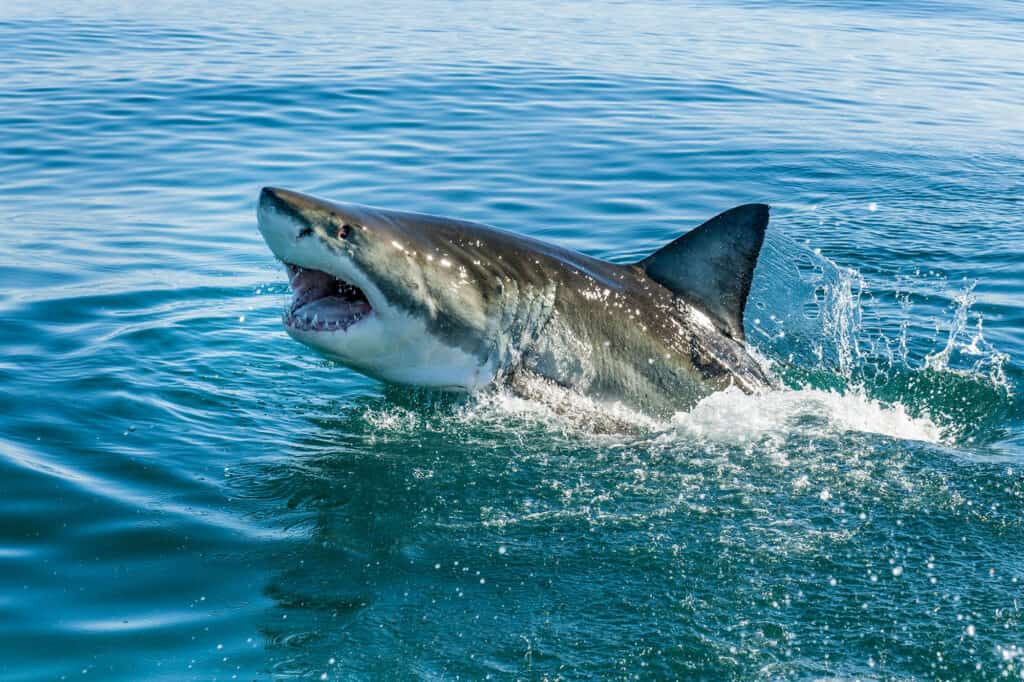
Great white sharks have an incredible sense of smell and keen eyesight, which allows them to see well in both bright light and low-light conditions.
©iStock.com/ELizabethHoffmann
Sharks have been a subject of fascination and fear for many people. While they are often portrayed as ferocious predators, the reality is that most shark attacks on humans are not intentional. In fact, the vast majority of shark attacks on humans are cases of mistaken identity. Here’s a closer look at why sharks attack people and what you can do to minimize the risk.
Mistaken Identity is one of the main reasons that sharks attack people Sharks are predators and naturally curious creatures. They may mistake a swimmer or surfer for one of their natural prey, such as a seal. This can lead them to bite a person, only to realize they made a mistake and quickly swim away. This is often the case in areas where seals and other prey are common, and the water is murky or visibility is limited.
Another reason why sharks attack people is due to provocation. This can occur when a person is fishing, swimming, or surfing in close proximity to a shark. The shark may feel threatened by the person’s presence and may attack to protect itself. This type of attack is more likely to occur when the shark is feeding or has a young pup nearby.
In some cases, sharks may attack people because they are injured or diseased. A shark in poor health may be more aggressive and less able to distinguish between prey and non-prey. Additionally, a shark that is injured may attack a person out of desperation or in an attempt to protect itself.
Human behavior can also contribute to shark attacks. People who engage in risky activities, such as swimming in areas known to be inhabited by sharks or fishing near shark nurseries, increase the risk of a shark attack.
Additionally, people who enter the water with open wounds or who bleed in the water can attract sharks and increase the risk of an attack.
Is It Normal For Sharks To Stalk Their Prey?
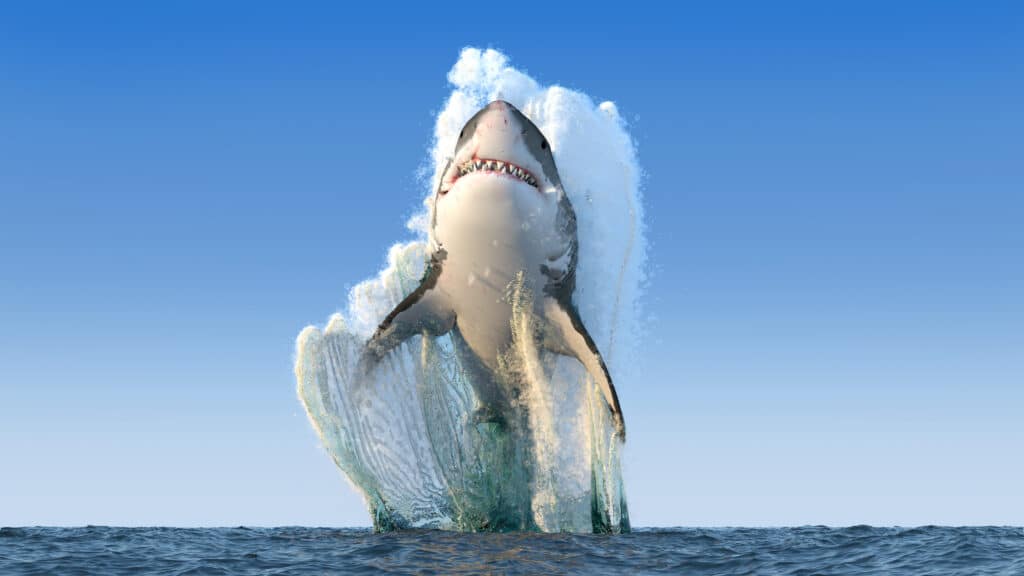
Sharks are also capable of detecting the electric fields of concealed prey
©Alexyz3d/Shutterstock.com
Yes, it is normal for sharks to stalk their prey in the wild. Sharks circle their prey when they are hunting and spot something in the water. It may not be due to hunger, it may be due to curiosity since sharks are naturally curious creatures.
Sharks have great vision, they will often rely on their ability to detect the electric fields of hidden prey and are forced to take extra time to fully understand what they are stalking.
Other Amazing Videos You Might Like
A shark can be seen leisurely swimming in the blue-green sea. Life’s unhurried when you’re a predator. The shark can be seen examining unusual objects in its environs, on one occasion, seeming to chomp on floating seaweed. As it swims on, it encounters two seabirds which take off immediately. It encounters two more, which do the same.
But a fifth covered in dark plumage seems to be unable to do so. It swims swiftly away from the curious shark which follows even if it does not put its fin on the gas. At last, a white cloud shoots from the bird to the predator – which the videographer declares to be a joke. They do not show us the outcome of that interaction but move on to show the shark approaching a paddleboarder and lose interest when the human scrambles onto his board.
How Large are Adult Great White Sharks?
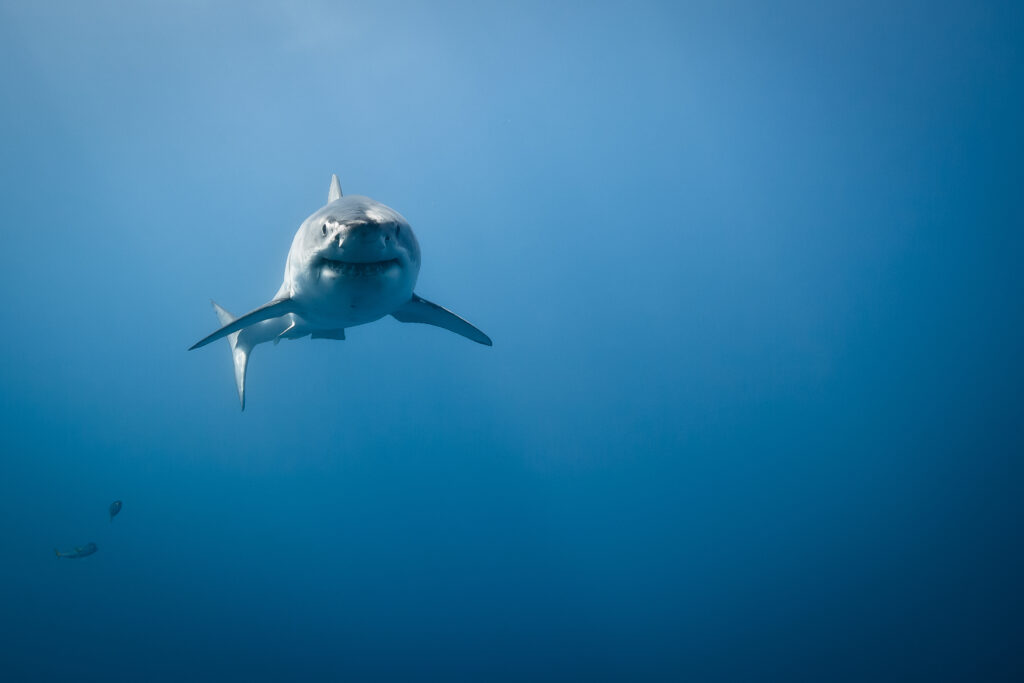
Deep Blue is the largest great white on record and was spotted in the Pacific Ocean near the coast of Guadalupe Island, Mexico.
©iStock.com/vladoskan
Adult great white sharks can reach lengths of up to 20 feet, although the majority are smaller than this. Females are generally larger than males, with the average size of female great whites reaching between 15-16 feet, and the average size of males reaching between 11-13 feet. The largest great white on record is a great white shark named Deep Blue, who is over 20 feet long and weighs an estimated 2.5 tons.
Thank you for reading! Have some feedback for us? Contact the AZ Animals editorial team.






